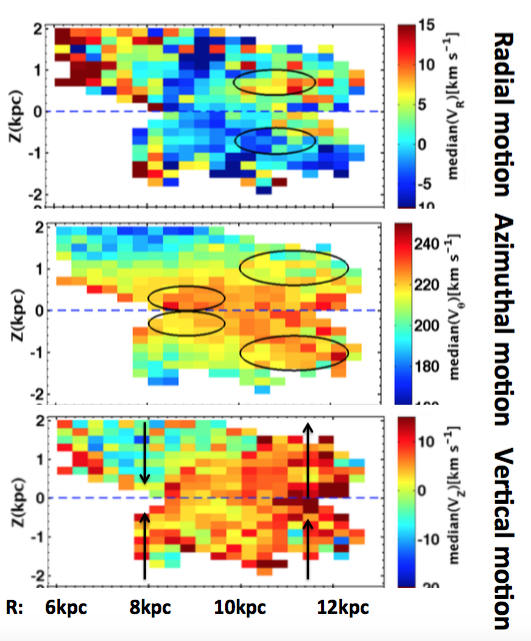Chinese Astronomers Make Some Discoveries in the Galactoseismology with LAMOST Data
There are non-axisymmetries in the Milky Way disk, since many velocity substructures, streams, and moving groups such as Coma Berenices, Sirius, Hyades, Pleiades, HD 1614, Arcturus were discovered. One of the most famous is the Hercules stream which might be caused by the Galactic bar's outer Lindblad resonance (OLR). Other asymmetric structures can be created by internal perturbations due to the bar or spiral arms, by external minor mergers such as the Sagittarius dwarf galaxy passing by, or by interaction with the Magellanic Clouds.
New asymmetrical motions have also been identified in recent years and the Galactic disk has been found to be oscillating in both stellar density and kinematics in the solar neighbourhood by many works, the use of these ``ripples'' in the disk to identify the perturber has come to be known as Galactoseismology.
There is not yet consensus regarding the physical scenario for producing vertical, radial and rotational asymmetries. Some researchers showed that asymmetric motions may be related to the age of stars with different dynamical relaxation times. The nearby asymmetric radial motions can be explained by the perturbation due to either the spiral arms or the bar in some literatures. However, the asymmetric radial motions in outer disk are likely mainly contributed by the bar dynamics with a given pattern speed. The explanation must be more complex for vertical asymmetrical structure, including scenarios such as minor mergers due to the passing of the Sagittarius dwarf galaxy proposed by some researchers or the LMC, or the disk response to bombardment by merging lower-mass satellites . The effects of even lower-mass dark matter sub-halos have also been invoked as a possible explanation. The stellar disk has a clear warp. According to simple analyses of vertical velocities, the kinematical signature of the Galactic warp's line-of-nodes is located close to the Galactic anti-center. This is also a possible explanation of the observed vertical bulk motions.
All these works show that we need more data and higher precision proper motions to map the disk kinematical details. And we must try our best to further investigate radial, azimuthal and vertical velocities in the Galactic outer disk. We are aspiring to figure out whether there are velocity asymmetrical motions as far away from the solar location at low Galactic latitudes. The LAMOST spectroscopic survey is used to select a larger sample of K giant stars with line-of-sight velocities and metallicities than was previously available. After these K-giants are combined with the GPS1(Gaia-PanSARRAS-SDSS) proper motion catalogue, which has unprecedented precision before Gaia DR2, we can decipher the outer disk 3-dimensional kinematical structure and asymmetries in detail.
Recently, Chinese astronomers Dr. Haifeng Wang, Dr. Licai Deng collaborate with Spanish astronomer Martin Lopez-Corredoira and American astronomer Jeffray Carlin to investigate the kinematics of K giant stars in the Galactic disk between R = 6 to 13kpc, Z = -2 to 2kpc with the GPS1 proper motion catalogue. From asymmetrical variations of the velocities with Galactocentric radius and height for 65000 K giant or RGB stars, They find that the median radial velocity profile has a large northern oscillating structure from R=6kpc to 13kpc. There is velocity substructure located at Z~0.5kpc and R~10-11kpc for the radial velocity distribution corresponding to the north-near overdensity they have confirmed previously.
They discover asymmetrical rotational motions when comparing stars above and below the plane at R> 10kpc and |Z|> 0.5kpc. Stars in the south are, on average, rotating faster than those in the north. At R ~ 8-9kpc, |Z|< 0.5kpc, they show that the northern stars are rotating faster than their counterparts in the south.
They also find that there is a compression motion at radii inside the solar location, and upward asymmetrical bulk motions outside the solar radius until~ 13kpc. The radial profile of median vertical velocity displays a trend from downward to upward bulk motions in the range of 6 to 13kpc, with all regions in this work beyond R >9kpc moving upward on average.
With the help of previous works, they discuss that in-plane asymmetries are not mainly contributed by the spiral arms or minor merger, and because they see vertical asymmetries, they can rule out that the vertical features are mainly caused by spiral arms or the bar. They cannot exclude contributions such as the warps, the dark matter halo, or other mechanisms. It will require more detailed mapping of disk velocity substructure(s) to decipher the mechanisms creating these structures in the future.

Fig1: 3 dimensional asymmetrical velocity distributions, top one is radial velocity distribution, middle one is azimuthal velocity, bottom one is vertical velocity. The ellipses and arrows are showing some asymmetrical features.